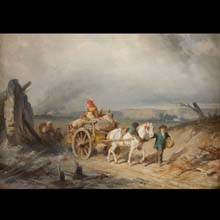
material: oil on canvas
dimensions: 32 × 45 cm
description: Henryk Pillati was one of the leading representatives of the social realism movement in Polish painting. He was associated with the Warsaw circle throughout almost all his professional career. In accordance with the imperatives of realism, expecting artists to record the present day, the artist painted genre scenes from the lives of the lower middle class as well as the urban, and more seldom rural, proletariat. Besides colourful, cheerful representations of markets, parties and church fairs, Pillati also portrayed episodes from the life of the poorest: fires and escapes, beggars and those doing the worst-paid jobs. The painting Escape whose form reminds of the works of Dutch Little Masters, shows fire victims leaving their burnt homestead. An attempt at the realist representation of the tragic event is combined with elements of anecdote. The gravity of the scene is highlighted by the bleak landscape. A muted palette, based on cold shades of grey, beige and blue, is relieved by accents of red in people’s garments and a horse collar. Aleksandra Krypczyk
exposition: The Gallery of 19th Century Polish Art in Sukiennice,
The Cloth Hall, 1, Main Market Square
key: Realism, polish impressionism, beginnings of symbolism >>>
dimensions: 32 × 45 cm
description: Henryk Pillati was one of the leading representatives of the social realism movement in Polish painting. He was associated with the Warsaw circle throughout almost all his professional career. In accordance with the imperatives of realism, expecting artists to record the present day, the artist painted genre scenes from the lives of the lower middle class as well as the urban, and more seldom rural, proletariat. Besides colourful, cheerful representations of markets, parties and church fairs, Pillati also portrayed episodes from the life of the poorest: fires and escapes, beggars and those doing the worst-paid jobs. The painting Escape whose form reminds of the works of Dutch Little Masters, shows fire victims leaving their burnt homestead. An attempt at the realist representation of the tragic event is combined with elements of anecdote. The gravity of the scene is highlighted by the bleak landscape. A muted palette, based on cold shades of grey, beige and blue, is relieved by accents of red in people’s garments and a horse collar. Aleksandra Krypczyk
exposition: The Gallery of 19th Century Polish Art in Sukiennice,
The Cloth Hall, 1, Main Market Square
key: Realism, polish impressionism, beginnings of symbolism >>>












